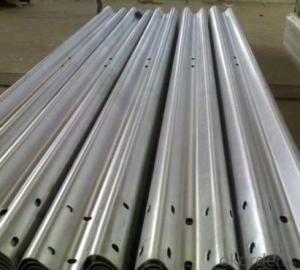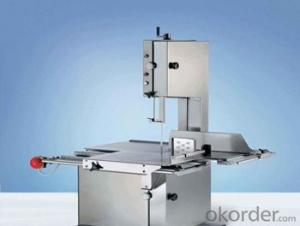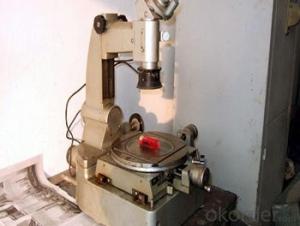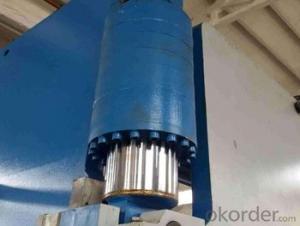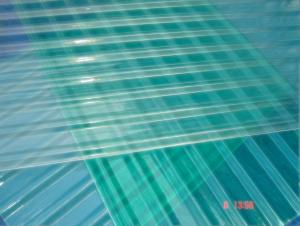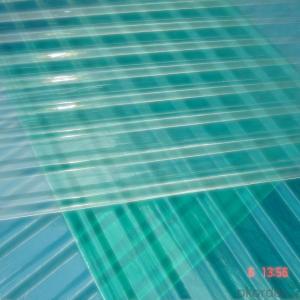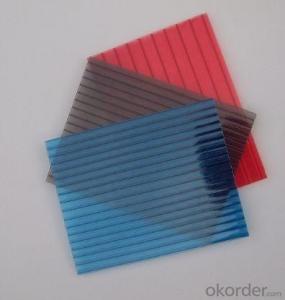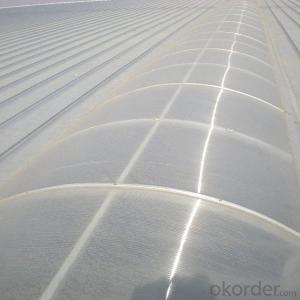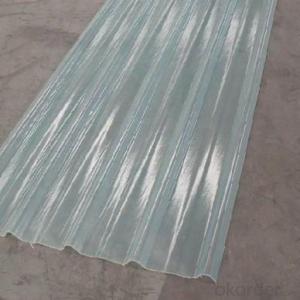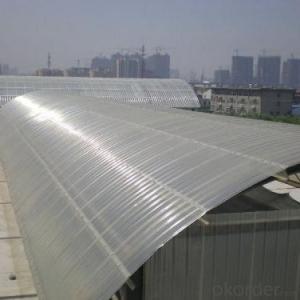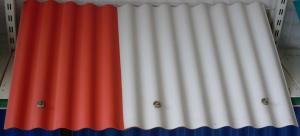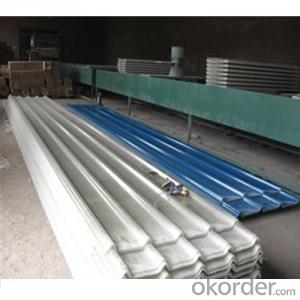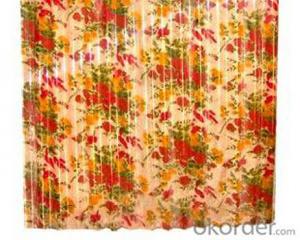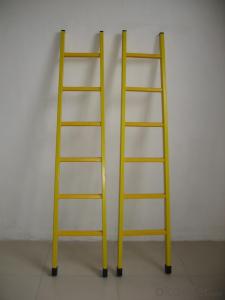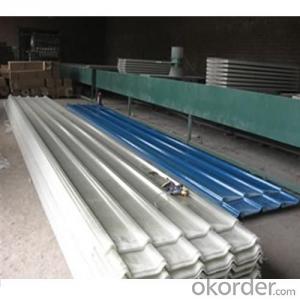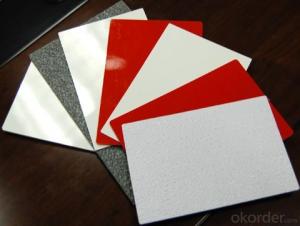FRP Translucent Fibreglass Corrugated Roofing Sheets
- Loading Port:
- Tianjin
- Payment Terms:
- TT OR LC
- Min Order Qty:
- 300 m
- Supply Capability:
- 80000 m/month
OKorder Service Pledge
OKorder Financial Service
You Might Also Like
Item specifice
PRODUCT DESCRIPTION
Fibreglass / Fiberglass Reinforced Plastic (FRP) or Glass Fiber Reinforced Plastic (GRP) is composed of thermosetting plastics and reinforced fiberglass, Greater than that of steel products and aluminum products in specific tenacity. Products in the ultra-low temperature or high temperature will not happen brittle fracture, deformation and to prevent heat transfer. Corrosion products in the environment anti-aging, yellowing resistance, corrosion resistance, friction resistance, easy to clean. Can be instead of aluminum, stainless steel plates, tiles and so on.
FEATURES
Corrosion resistance,last 10-15 years life span
Color stable.
Sound absorption and heat insulation.
Good water resistance.
Fireproof resistance.
Easy to install.
Good impact and low temperature resistance.
Light weight.
Stable volume.
SPECIFICATIONS
| Name: | Fibreglass Reinforced Polyester(FRP ) Sheet |
| Material: | Protective film, Unsaturated resin polyester, Fiberglass |
| Weight: | 1800g/2400g/2750g/3050g Square meter |
| Thickness: | 0.8~3.0mm |
| Length: | Customized |
| Temp: | used in -40°c to 140 °c |
| OEM: | Welcomed |
| Color: | Clear/Blue |
PICTURES
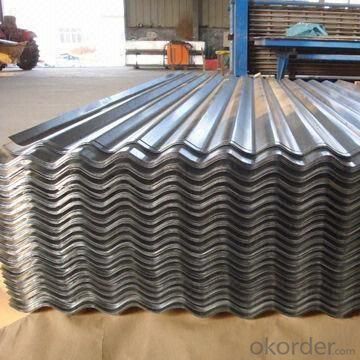
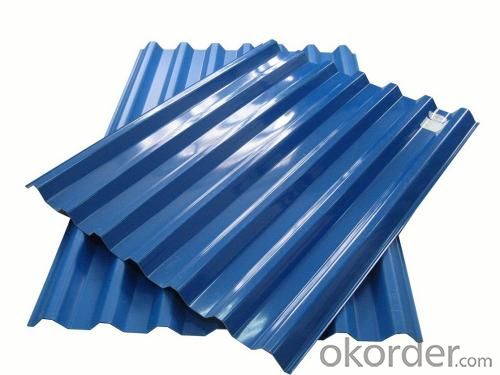
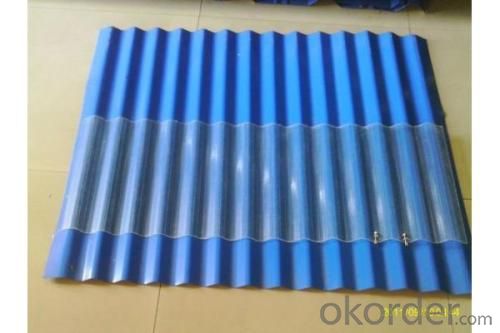
- Q:Can FRP roofing panels be used in areas with extreme temperature fluctuations?
- FRP roofing panels are capable of withstanding extreme temperature fluctuations, making them suitable for use in areas with varying climate conditions. These panels possess exceptional thermal expansion and contraction attributes, ensuring that they do not deform or crack when exposed to temperature changes. The materials utilized in FRP panels are specifically designed to resist temperature variations, enabling their installation in regions characterized by both scorching summers and freezing winters. Moreover, FRP panels offer efficient insulation properties that contribute to maintaining a comfortable indoor temperature and reducing energy consumption. Nevertheless, it is always advisable to seek guidance from a professional roofing contractor or manufacturer to ensure that the chosen FRP panel is appropriate for the specific climate and temperature conditions of the area.
- Q:Are FRP roofing panels compatible with different types of flashing systems?
- Yes, FRP roofing panels are compatible with a variety of flashing systems. These panels can be easily integrated with different types of flashing systems, such as metal or PVC, to ensure proper waterproofing and protection against leaks. Proper installation and sealing techniques are crucial to ensure a secure and durable connection between the FRP panels and the flashing system.
- Q:Do FRP roofing panels require a specific type of insulation?
- No, FRP roofing panels do not necessarily require a specific type of insulation. The type of insulation required depends on various factors such as the climate, building design, and specific requirements of the project. However, it is generally recommended to use insulation materials that are compatible with the FRP panels and provide adequate thermal resistance. Common types of insulation used with FRP roofing panels include rigid foam insulation, fiberglass batts, and spray foam insulation. It is important to consult with a professional or refer to the manufacturer's guidelines to determine the most suitable insulation for your specific FRP roofing system.
- Q:Can FRP roofing panels be used in cold climates?
- Yes, FRP roofing panels can be used in cold climates. FRP (Fiberglass Reinforced Plastic) panels are known for their durability and resistance to extreme weather conditions, including cold temperatures. They can withstand freezing temperatures and provide effective insulation, making them suitable for use in cold climates.
- Q:Do FRP roofing panels have any specific building code approvals?
- Yes, FRP (Fiberglass Reinforced Plastic) roofing panels do have specific building code approvals. The specific building code approvals may vary depending on the region or country, as each jurisdiction may have its own set of regulations and standards. However, in general, FRP roofing panels need to meet certain criteria to receive building code approvals. The building code approvals for FRP roofing panels typically include factors such as fire resistance, wind uplift resistance, impact resistance, and structural stability. These approvals ensure that the panels can withstand various environmental conditions and contribute to the overall safety and stability of the building. To obtain building code approvals, manufacturers of FRP roofing panels must comply with the relevant building codes and standards set forth by local regulatory bodies. This often involves rigorous testing and certification processes conducted by independent testing laboratories. These tests evaluate the panels' performance in different scenarios, such as fire exposure, wind pressure, and impact resistance. It is important for builders and contractors to verify the specific building code approvals of FRP roofing panels before using them in construction projects. This can be done by checking the product documentation provided by the manufacturer, which should clearly state the approvals and certifications obtained. By ensuring that FRP roofing panels have specific building code approvals, construction professionals can be confident that the panels meet the necessary safety and performance requirements for their intended use. This helps to maintain compliance with local building codes and regulations and promotes the overall quality and longevity of the roofing system.
- Q:Do FRP roofing panels require special maintenance?
- Yes, FRP roofing panels require special maintenance. Regular cleaning and inspection are essential to prevent the buildup of dirt, debris, and algae on the surface. Additionally, it is important to check for any signs of damage, such as cracks or leaks, and address them promptly to ensure the longevity and performance of the panels.
- Q:Can FRP roofing panels be used for outdoor structures like sheds or pergolas?
- Yes, FRP roofing panels can definitely be used for outdoor structures like sheds or pergolas. FRP (fiberglass reinforced plastic) roofing panels are known for their durability and resistance to weather elements, making them an ideal choice for outdoor applications. They are lightweight, yet strong, and can withstand harsh weather conditions such as rain, snow, and UV rays without deteriorating or losing their structural integrity. Additionally, FRP roofing panels are easy to install and maintain, making them a practical and cost-effective option for outdoor structures.
- Q:Can FRP roofing panels be used for car wash structures or detailing bays?
- Yes, FRP (Fiberglass Reinforced Plastic) roofing panels can be used for car wash structures or detailing bays. FRP roofing panels are known for their durability, strength, and resistance to corrosion, making them ideal for environments such as car washes where they may be exposed to water, chemicals, and constant use. FRP panels are lightweight, which makes them easy to install on the roof of car wash structures or detailing bays. They can also be easily customized to fit the specific design requirements of the building. Additionally, FRP roofing panels have excellent weathering properties, ensuring that they will remain structurally sound and aesthetically appealing for an extended period, even when exposed to the elements. Furthermore, FRP panels are non-conductive, meaning they do not conduct electricity. This is particularly important in car wash structures or detailing bays where electrical equipment, such as lighting or power outlets, are commonly used. The non-conductive nature of FRP roofing panels helps to reduce the risk of electrical accidents and ensures the safety of both the workers and customers. Overall, FRP roofing panels are an excellent choice for car wash structures or detailing bays due to their durability, resistance to corrosion, ease of installation, weathering properties, and non-conductive nature. Using FRP panels can help ensure a long-lasting and safe environment for car wash operations.
- Q:How does FRP roofing panel differ from other roofing materials?
- FRP (Fiberglass Reinforced Plastic) roofing panels differ from other roofing materials in several ways. Firstly, FRP panels are made of a composite material consisting of a plastic matrix reinforced with fiberglass fibers. This composition gives them exceptional strength and durability, making them resistant to impact, weathering, and corrosion. Another significant difference is their lightweight nature. FRP roofing panels are considerably lighter than many traditional roofing materials such as metal or concrete tiles. This characteristic makes them easier to handle during installation and reduces the structural load on the building, potentially lowering construction costs. FRP roofing panels also offer excellent thermal insulation properties. They can effectively reflect sunlight, reducing heat absorption and maintaining a cooler environment underneath. This insulation property can contribute to energy savings and a more comfortable indoor climate, especially in hot climates. Furthermore, FRP panels are highly versatile in terms of design and customization options. They can be manufactured in various colors, shapes, and sizes to suit architectural requirements. They can also be fabricated to mimic the appearance of other roofing materials like shingles or tiles, providing a visually appealing alternative. Lastly, the installation process for FRP roofing panels is relatively straightforward and cost-effective. They can be easily cut and shaped on-site, allowing for quick and efficient installation. Additionally, their lightweight nature reduces the need for specialized equipment and labor, potentially reducing installation costs. In summary, the main differences between FRP roofing panels and other roofing materials are their exceptional strength, lightweight nature, thermal insulation properties, design flexibility, and ease of installation. These qualities make FRP panels a popular choice for both residential and commercial roofing applications.
- Q:Can FRP roofing panels be installed on historical or heritage buildings?
- FRP roofing panels, also known as fiberglass reinforced plastic roofing panels, can indeed be installed on historical or heritage buildings. However, there are certain considerations that need to be taken into account before proceeding with the installation. First and foremost, it is crucial to assess the historical significance of the building and evaluate the impact that installing FRP roofing panels would have on its overall integrity and aesthetic value. Some historical or heritage buildings may be protected by strict conservation regulations, and any alteration to the original structure may require permission or approval from the relevant authorities. Additionally, the compatibility of FRP roofing panels with the existing roof structure needs to be carefully evaluated. Historical buildings often have unique architectural features, such as intricate designs, delicate materials, or unconventional roof shapes. It is important to ensure that the installation of FRP panels does not compromise the structural integrity or alter the appearance of these distinctive characteristics. Moreover, the choice of FRP roofing panels should be made with consideration for the specific requirements of historical buildings. Opting for panels that mimic the appearance of traditional roofing materials, such as clay tiles or slate, can help maintain the historical aesthetics while benefiting from the durability and longevity of FRP. Lastly, it is advisable to consult with professionals experienced in working with historical or heritage buildings and materials. These experts can provide valuable insights and guidance on the best practices for installing FRP roofing panels without compromising the historical value or architectural integrity of the structure. In conclusion, while it is possible to install FRP roofing panels on historical or heritage buildings, thorough research, evaluation, and consultation with experts are essential to ensure that the installation is carried out in a manner that respects and preserves the building's historical significance.
1. Manufacturer Overview |
|
|---|---|
| Location | |
| Year Established | |
| Annual Output Value | |
| Main Markets | |
| Company Certifications | |
2. Manufacturer Certificates |
|
|---|---|
| a) Certification Name | |
| Range | |
| Reference | |
| Validity Period | |
3. Manufacturer Capability |
|
|---|---|
| a)Trade Capacity | |
| Nearest Port | |
| Export Percentage | |
| No.of Employees in Trade Department | |
| Language Spoken: | |
| b)Factory Information | |
| Factory Size: | |
| No. of Production Lines | |
| Contract Manufacturing | |
| Product Price Range | |
Send your message to us
FRP Translucent Fibreglass Corrugated Roofing Sheets
- Loading Port:
- Tianjin
- Payment Terms:
- TT OR LC
- Min Order Qty:
- 300 m
- Supply Capability:
- 80000 m/month
OKorder Service Pledge
OKorder Financial Service
Similar products
New products
Hot products
Hot Searches
Related keywords
